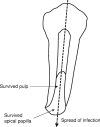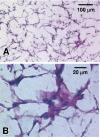The hidden treasure in apical papilla: the potential role in pulp/dentin regeneration and bioroot engineering
- PMID: 18498881
- PMCID: PMC2653220
- DOI: 10.1016/j.joen.2008.03.001
The hidden treasure in apical papilla: the potential role in pulp/dentin regeneration and bioroot engineering
Abstract
Some clinical case reports have shown that immature permanent teeth with periradicular periodontitis or abscess can undergo apexogenesis after conservative endodontic treatment. A call for a paradigm shift and new protocol for the clinical management of these cases has been brought to attention. Concomitantly, a new population of mesenchymal stem cells residing in the apical papilla of permanent immature teeth recently has been discovered and was termed stem cells from the apical papilla (SCAP). These stem cells appear to be the source of odontoblasts that are responsible for the formation of root dentin. Conservation of these stem cells when treating immature teeth may allow continuous formation of the root to completion. This article reviews current findings on the isolation and characterization of these stem cells. The potential role of these stem cells in the following respects will be discussed: (1) their contribution in continued root maturation in endodontically treated immature teeth with periradicular periodontitis or abscess and (2) their potential utilization for pulp/dentin regeneration and bioroot engineering.
Figures





References
-
- Iwaya SI, Ikawa M, Kubota M. Revascularization of an immature permanent tooth with apical periodontitis and sinus tract. Dental Traumatol. 2001;17:185–7. - PubMed
-
- Banchs F, Trope M. Revascularization of immature permanent teeth with apical periodontitis: new treatment protocol? J Endod. 2004;30:196–200. - PubMed
-
- Chueh L-H, Huang GTJ. Immature teeth with periradicular periodontitis or abscess undergoing apexogenesis: A paradigm shift. J Endod. 2006;32:1205–13. - PubMed
Publication types
MeSH terms
Grants and funding
LinkOut - more resources
Full Text Sources
Miscellaneous

